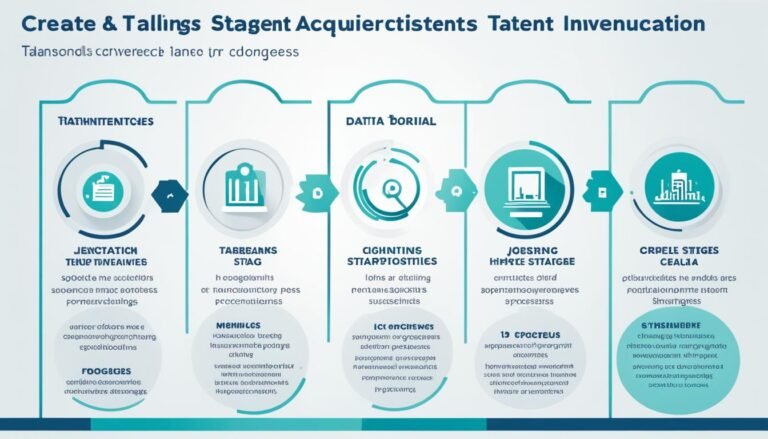How does strategic planning contribute to business success?
Strategic planning is key to making big changes. It helps companies move forward and reach their goals. When used well, it brings many advantages and sets the stage for growth and making money over a long period.
So, why is this planning so vital for businesses? We’ll dig into this key strategy and its importance. We’ll see how strategic planning shapes an organization’s future and its mission. Plus, we’ll check out how planning smartly allocates resources, boosts new ideas, and improves how people work together and talk to each other.
But, let’s understand first why strategic planning is vital for any business to thrive.
Key Takeaways:
- Strategic planning is crucial for business success.
- It provides direction and aligns stakeholders towards a common goal.
- Strategic planning enhances decision-making and resource management.
- It fosters innovation and adaptability in response to changing market dynamics.
- Effective communication and collaboration are facilitated through strategic planning.
What is strategic planning?
Strategic planning guides a business’s future path. It helps decide where efforts should go and how to use resources wisely. Everyone involved works towards the same clear goals. This approach is not random; it is based on careful analysis and reasons.
Additionally, it is not a single project. It’s a continual effort that changes with new chances and risks.
Definition of Strategic Planning
It’s how an organization maps its route and decides how to use its resources. This helps pursue the set path.
“Strategic planning is an ongoing organizational process that involves systematically defining a company’s direction and allocating associated resources towards achieving predetermined objectives.”
Ongoing Process of Strategic Planning
Strategic planning is a never-ending operation. It always needs to be monitored and sometimes adjusted. This is because markets and customer needs change. Being flexible is key to facing the unknown.
It plays a huge role in a company’s success. It guides choices, uses resources wisely, and makes sure everyone is on the same page. With it, companies can spot and grab good opportunities, face problems, and stay ahead in the market.
Key Elements of Strategic Planning
To grasp strategic planning, key elements need to be looked at:
- Goal Setting: It means setting clear, SMART goals that fit with the bigger dreams and plans of the company.
- Situational Analysis: Looking deep into what’s around, in the company and outside, helps spot room for improvement and growth.
- Strategy Formulation: After looking at the situation, plans are made to fix issues and grab opportunities. These plans lay out who does what, by when, and how goals will be met.
- Execution and Implementation: These plans then are put into action. They outline actions, timelines, and checks to follow progress.
- Performance Monitoring: Keeping an eye on how well plans work is crucial. It helps make changes when needed so goals stay on track.
| Key Benefits of Strategic Planning |
|---|
| 1. Provides a clear direction and purpose for the organization |
| 2. Enhances decision-making by facilitating data-driven choices |
| 3. Enables effective resource allocation and optimization |
| 4. Aligns shareholders and employees towards common goals |
| 5. Positions the organization for scalability and growth |
Benefits of strategic planning
Strategic planning is a key tool for organizations. It creates a common vision for all to follow. This vision aligns everyone towards a shared goal.
With a clear vision, companies can tackle tough issues and make wise choices. Strategic planning helps spot biases and logical errors. This means companies can avoid mistakes and decide wisely.
A major plus of strategic planning is tracking progress on set goals. Companies define clear objectives. Then, they watch their steps closely to be sure they’re on the right path. This improves accountability and boosts performance.
Strategic planning lays the groundwork for success. It lets companies steer their efforts, spot chances and dangers, and reach their goals.
In the end, strategic planning gives organizations the power to shape their own future. It helps in making smart decisions. And it creates a culture of everyone working together, being accountable.
Key Benefits of Strategic Planning
| Benefits | Description |
|---|---|
| Create one forward-focused vision | Aligns stakeholders towards a common goal |
| Draw attention to biases and flaws in reasoning | Improves decision-making processes |
| Track progress based on strategic goals | Enhances alignment and drives performance |
Importance of strategic planning in defining vision and mission
Defining an organization’s vision and mission is key in strategic planning. It gives them a clear purpose and direction. This clarity helps all members know where they are headed and work together.
The vision sets high goals for the future. On the other hand, the mission describes why the organization exists. Together, they guide decision-making and keep everyone focused on a common goal.
Having a clear vision and mission aids in strategic decision-making. It helps evaluate options against the organization’s goals. This way, strategies stay in line with what the organization stands for.
Defining vision and mission is more than just writing statements. It’s about showing what the organization truly believes. It should inspire its members and attract others who share the same values.
A well-thought-out vision and mission also improve internal collaboration. It makes employees see how their work fits into the whole. This boosts a culture of teamwork and a feeling of working towards something meaningful.
Example Table – Vision and Mission Statements
| Organization | Vision Statement | Mission Statement |
|---|---|---|
| To organize the world’s information and make it universally accessible and useful. | To organize the world’s information and make it universally accessible and useful. | |
| Apple | We believe that we’re on the face of the Earth to make great products. | To bring the best user experience to its customers through its innovative hardware, software, and services. |
| Amazon | To be Earth’s most customer-centric company, where customers can find and discover anything they might want to buy online. | To be Earth’s most customer-centric company, where customers can find and discover anything they might want to buy online, at the lowest possible prices. |
Table: Examples of Vision and Mission Statements in Prominent Organizations
Effective resource allocation through strategic planning
Strategic planning is vital for how organizations use their resources. It looks at what a company can do, what the market is like, and its competition. This helps companies see what they’re good at and where they need to improve. Then, they can make smart choices about where to put their time and money to get ahead.
Through smart thinking, companies can see where to focus their efforts. They combine what they do best with what the market needs most. This approach makes sure they use everything wisely. They don’t waste anything and get the best results.
Strategic planning also keeps an eye on the market and what others are doing. This means watching trends, what customers want, and what rivals are up to. With this info, companies can change their plans and use their resources the best way. This way, they’re always working to be better than the rest.
Focusing on important goals helps companies choose what’s most crucial. By picking projects that help them reach their big dreams, companies make the best use of what they have. This keeps them moving towards success. It helps them keep their eyes on the prize.
The Role of Data in Resource Allocation
Data is key to making good choices about resources. It tells companies what’s going on now and what might happen next. With facts in hand, they can make sure their plans support their goals well.
“Data is the lifeblood of effective resource allocation. By leveraging data-driven insights, organizations can allocate resources strategically and make informed decisions.”
Using data means making decisions without just guessing. It lets companies find where they’re not doing the best. Then, they can fix those areas or put their efforts somewhere else. This method helps them do things that really matter and lead to their success.
Case Study: Successful Resource Allocation in Strategic Planning
Amazon is a great example of using smart planning to allocate resources well. It looks at what the market wants, what customers need, and what others in the business are doing. Then, it puts its efforts into things that make it stand out, like fast shipping and great service.
This approach has made Amazon a top player. It’s always coming up with new ideas, using the latest tech, and making sure customers are happy. Amazon stays in the lead by always being ready for what the market throws at it.
Getting resource allocation right is a huge part of why businesses do well. By studying their own strengths, the market, and the competition, companies can use their resources wisely. This means they do what really helps them grow and beat the competition. Mixing strategic planning with clever resource use helps companies keep getting better and reaching their goals.
Agility and adaptability in strategic planning
Today’s business world moves fast. To succeed, companies need to be able to change and adjust quickly. Strategic planning helps them do this. It allows businesses to get ready for and respond to new challenges.
Being agile means a company can easily change its plans to fit what’s happening in the market. It lets them use their skills and resources in the best way. This way, they can jump on new chances quickly. Checking and updating their plans regularly helps them make sure they are always on the right track.
Adaptability means being able to deal with unexpected problems. It might mean changing goals or finding new ways to solve issues. Being ready for surprises makes a company stronger in tough times.
Strategic planning teaches organizations to keep learning and getting better. It’s about being open to new ideas and working with others. This way, companies can always improve how they work. They can stay sharp in a fast-moving world.
“Agility and adaptability are key in strategic planning. They help organizations face change, find new chances, and grow strong.”
Agility and Adaptability in Action: Apple’s Strategic Planning
Apple knows how to be quick and change to meet what people want. They focus on making tech that’s easy to use and that works well together. This approach has made them stand out in the tech world.
By always being ready for the next big thing, Apple keeps its place as a leader. It’s not just about making cool products; it’s about making what people need. This has been central to Apple’s success.
| Benefits of Agility and Adaptability in Strategic Planning |
|---|
| 1. Flexibility: Agility and adaptability enable businesses to flexibly respond to changes in the market, technology, and customer demands. |
| 2. Competitive advantage: Organizations that embrace agility and adaptability gain a competitive edge by staying ahead of the competition. |
| 3. Innovation: Agility and adaptability foster a culture of innovation, enabling organizations to explore new opportunities and challenge existing norms. |
| 4. Resilience: By being agile and adaptable, organizations can navigate challenges and disruptions effectively, ensuring their long-term sustainability. |
| 5. Optimized resource allocation: Agility and adaptability in strategic planning allow businesses to optimize resource allocation, ensuring the efficient use of time, money, and talent. |
Being agile and adaptable is crucial in today’s market. These qualities help organizations deal with change, find new ways to grow, and stay strong. By being open to change and keeping their plans dynamic, businesses can face anything. Strategic planning is essential in enabling this agility and adaptability. It helps businesses grow and succeed in a fast-changing world.
Proactive risk management through strategic planning
Strategic planning goes beyond setting goals. It’s also great for handling risks before they become real issues. By thinking about risk while planning, groups can spot and fix weak spots. This way, they are ready if something unexpected happens.
This type of risk management looks at and deals with dangers early on. In planning, it means looking closely at every risk that might stop you from reaching your goals.
By looking at risks deeply, groups really get what could go wrong. They check both inside and outside things that might cause trouble. Doing this helps pick the most important risks. Then, they can put the right people and plans in place to fight these risks.
Figuring out where the group is weak is key. This is about seeing where trouble could get in easily. By getting these points, groups can fix them before any harm comes. Doing this makes actual problems less likely to hit hard.
After finding the risks, it’s time to make plans to fight them. This means preparing other ways to do things if a risk shows up. Making these plans before problems happen helps. It makes sure the group can quickly react well. This might save from losing money or a bad reputation.
Putting risk handling in your plan makes you ready for surprises and changes. It helps to deal with problems and use chances for growth. Facing risks by planning makes a business stronger and more successful.
| Benefits of Proactive Risk Management through Strategic Planning |
|---|
| 1. Minimizes the impact of unforeseen events |
| 2. Enhances organizational resilience |
| 3. Reduces financial losses and reputational damage |
| 4. Enhances decision-making by considering potential risks |
| 5. Provides a framework for effective resource allocation |
| 6. Enables organizations to seize growth opportunities |
Case Study: XYZ Corporation
“By looking for risks early in our plan, we found and fixed problems. This made sure we could handle any challenge. It’s been key to our success and power to bounce back.”
– John Smith, CEO of XYZ Corporation

Fostering innovation in strategic planning
In today’s fast-moving business world, innovation is vital for success. Companies that focus on innovation get ahead of the competition. They set themselves up for long-term success. Strategic planning is key to bringing innovation to organizations.
Strategic planning supports thinking outside the box and critical thought. It provides a structure for companies to find new chances and try out fresh ideas. Companies can hold organized brainstorming sessions. In these, employees work together to solve challenges in creative ways.
What’s more, strategic planning helps organizations use their resources wisely for innovation. By looking into market trends and what customers need, companies can figure out where to focus their research and development. This way, companies support their innovation well, giving it the best chance of success.
Strategic planning also encourages forming key partnerships. Teaming up with others, like new start-ups or experts in the field, brings in new viewpoints and technologies. These partnerships help in sharing knowledge and ideas. They create an atmosphere where innovation thrives and change is welcome.
An excellent model of strategic innovation is Apple. Through their strategic planning, Apple consistently introduces game-changing products. By thinking creatively and investing in advanced technology, Apple has become an innovation front runner.
“Innovation distinguishes between a leader and a follower.” – Steve Jobs
Strategic planning lets companies check and change their innovation plans regularly. This helps the company tweak their strategy as the market and customer needs change. It allows for a better and more agile approach to innovation.
Moreover, strategic planning encourages a culture of risk-taking and learning from failure. It helps companies see mistakes as stepping stones to success. With this approach and strategic backing, businesses can adapt quickly and embrace new ideas and technologies.
Wrap Up
Fostering innovation through strategic planning is crucial for companies today. It pushes them to think creatively and spend their resources wisely. It encourages them to work with others and always strive to do better. This approach helps companies grow sustainably and stay ahead in the ever-changing business world.
| Benefits of Fostering Innovation in Strategic Planning | Examples |
|---|---|
| 1. Competitive advantage | Apple |
| 2. Market disruption | Amazon |
| 3. Sustainable growth |
Enhanced communication and collaboration through strategic planning
Good communication and working together are key parts of successful planning. When groups work together on a plan, it encourages discussion and feedback. This helps make better choices, put resources where they are needed, and carry out plans well. Everyone feels like they own the plan, which drives success.
Open Dialogue and Constructive Feedback
Planning sessions are places for sharing thoughts and listening to others. This environment values every point of view, making it easier for people to talk without fear. Open talks bring different ideas to the table, leading to new and improved plans.
These sessions also welcome feedback. People can suggest changes and question ideas, which fine-tunes the plan. This open style of planning pushes for constant betterment and aligns everyone towards reaching their aims.
Shared Understanding and Alignment
In planning, everyone comes to one vision, mission, and goals for the group. Being part of planning gives everyone insight into what to focus on. It gets everyone working towards the same targets. This teamwork ensures efforts are not wasted and helps meet set objectives.
Efficient Resource Allocation and Execution
Talking and working together during planning means resources are well used. Everyone knows what’s needed and works to get it. This planned use of resources boosts the organization’s performance and success.
Add image here for enhanced visual appeal and relevance:
Collaboration in Action: An Example
“Through strategic planning, our organization was able to bring together our executive team, department heads, and front-line employees. This collaborative effort not only resulted in a comprehensive strategic plan but also fostered a culture of communication, transparency, and teamwork. Our employees felt heard and valued, which led to increased commitment, engagement, and ultimately, the successful execution of our strategic initiatives.”
Summary
Talking and teaming up better through planning improves choices, uses resources wisely, and gets plans done well. When everyone talks openly, suggests improvements, and understands the plan, they help the group succeed together.
| Benefits of Enhanced Communication and Collaboration in Strategic Planning | Examples |
|---|---|
| Improved decision-making | – |
| Efficient resource allocation | – |
| Effective execution of strategic initiatives | – |
Companies that excel in strategic planning
Many companies are known for top-notch strategic planning. Apple, Amazon, and Google lead this list. Their amazing planning is key to their big growth and success.
Apple: Design and user experience
Apple shines in design and user experience. They carefully plan and know what customers want. This results in products that look great and work well, connecting deeply with users.
Amazon: Customer obsession and experimentation
Amazon focuses on customers and trying new things. They study what people like and adjust their plans. This keeps Amazon ahead, delivering great value and service.
Google: Innovation, adaptability, and market trends anticipation
Google loves new ideas and keeping up with trends. It encourages creative thinking and trying out fresh concepts. This helps Google lead in technology and digital fields.
Companies with Successful Strategic Planning
| Company | Key Strategic Planning Focus |
|---|---|
| Apple | Design and user experience |
| Amazon | Customer obsession and experimentation |
| Innovation, adaptability, and market trends anticipation |
Apple, Amazon, and Google prove how smart planning boosts success. Their focus on innovation, customer needs, and being trendsetters keeps them strong and ahead in business.
Conclusion
Strategic planning is key to business success. It helps organizations know where they’re going. This makes it easier to make good decisions and handle resources well. When everyone works together towards clear goals, a company becomes more efficient and beats the competition.
ClearPoint Strategy is a great help in strategic planning. It’s a complete software for managing performance. It includes an AI Assistant, tools for leaders, ways for teams to work together, and strong reporting and integration features. With ClearPoint Strategy, managing the strategic planning process is much smoother.
Using ClearPoint Strategy, companies can do better. They can set a clear vision, use resources wisely, and encourage new ideas and flexibility. This way of strategic planning can lead organizations to meet their objectives and succeed in today’s fast-changing market.
FAQ
How does strategic planning contribute to business success?
Strategic planning helps a business find its way. It makes decisions better and manages resources wisely. By improving how things are done, organizations can achieve their goals more effectively.
What is strategic planning?
It’s the ongoing process of setting a business’s future course. It outlines where the business aims to go, points out areas that need attention, and moves the company forward. This method is about making smart choices, spending resources well, and getting everyone to work together towards success.
What are the benefits of strategic planning?
It gives organizations a clear, shared path to follow. It spots any flawed thinking and offers ways to choose better. By keeping an eye on how well they’re doing, businesses ensure they’re hitting their targets.
What is the importance of strategic planning in defining vision and mission?
It gives an organization a clear mission and vision. This clarity helps bring everyone together on the same goals. It focuses people’s work and promotes unity in moving towards those shared objectives.
How does strategic planning facilitate effective resource allocation?
By looking closely at what the business is good at and what the market needs, strategic planning figures out where to put resources. It is strategic in choosing what to invest in to outdo others.
How does strategic planning promote agility and adaptability?
Strategic planning helps businesses prepare for and react to changes quickly. It keeps them sharp and a step ahead by adjusting their strategies and where they put their resources.
How does strategic planning contribute to proactive risk management?
It gets businesses ready to face risks head-on. By carefully looking at potential dangers, finding weak spots, and planning ahead, they’re better guarded against surprises. This way, they can handle tough times and keep going strong.
How does strategic planning foster innovation?
It encourages businesses to think creatively and explore new ideas. It sets the stage for investing in innovation, research, and building key partnerships. This leads to growth in a way that stands out in the market.
How does strategic planning enhance communication and collaboration?
It gets everyone talking, sharing ideas, and feeling like they all own a part of the plan. It results in making better decisions, using resources well, and carrying out strategies more effectively.
Which companies excel in strategic planning?
Companies that stand out in strategy include Apple, Amazon, and Google. Apple is big on design, Amazon puts customers first and tests new ideas, while Google is known for being innovative and quick to spot what’s next.
How does strategic planning contribute to business success?
Strategic planning is key to making a business succeed. It gives them a clear path, sharpens their decision-making, and makes their operations run smoother. Tools like ClearPoint Strategy help make this process better by offering smart solutions to planning and managing performance.








